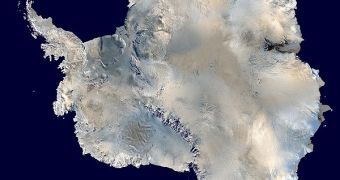British researchers have just recently announced the success of a fully robotized mission in the treacherous environment of the Antarctic, where Autosub, a machine built and developed by the UK National Oceanography Center in Southampton, has managed to complete a six-part mission. It has had to submerge itself under a giant glacier and take readings of the large block, so as to determine if and how global warming and climate change are affecting the ice sheet.
“Autosub is a completely autonomous robot: there are no connecting wires with the ship and no pilot. Autosub has to avoid collisions with the jagged ice overhead and the unknown seabed below, and return to a pre–defined rendezvous point, where we crane it back onboard the ship. Adding to the problems are the sub zero water temperatures and the crushing pressures at 1000 m depth. All systems on the vehicle must work perfectly while under the ice or it would be lost. There is no hope of rescue 60 km in, with 500 meters of ice overhead,” Autosub team leader Steve McPhail says.
The target, Pine Island Glacier, is located just off the West Antarctic ice sheet and represents a floating extension of the latter. The research that the new mission has conducted at the location is fundamental to understanding why the flow of glaciers to the sea has accelerated over recent decades, and why the once-massive chunks of ice are constantly getting thinner. Since the Pine Island Glacier has entered scientific observations, in the 1970s, it has contributed some 0.25 millimeters per year to the global rise in sea levels, alongside some of its neighbors.
“There is still much work to be done on the processing of the data, but the picture we should get of the ocean beneath the glacier will be unprecedented in its extent and detail. It should help us answer critical questions about the role played by the ocean in driving the ongoing thinning of the glacier,” British Antarctic Survey (BAS) scientist Dr Adrian Jenkins, who is the leader of the current expedition featuring experts from many countries, adds. All operations are conducted from the American RVIB Nathaniel B Palmer ship.
All the instruments on the Autosub, including sonars and thermometers, are used to determine how warming seas affect the base of the glaciers, as well as to monitor any potential changes in the salinity and temperatures of the waters surrounding the bulky mass of ice.

 14 DAY TRIAL //
14 DAY TRIAL //